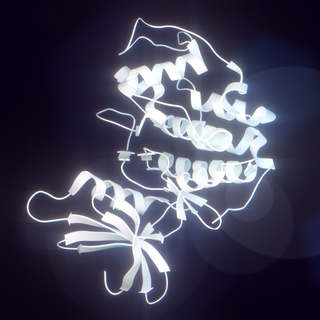
Enamelin is an enamel matrix protein (EMPs), that in humans is encoded by the ENAM gene. It is part of the non-amelogenins, which comprise 10% of the total enamel matrix proteins. It is one of the key proteins thought to be involved in amelogenesis. The formation of enamel's intricate architecture is thought to be rigorously controlled in ameloblasts through interactions of various organic matrix protein molecules that include: enamelin, amelogenin, ameloblastin, tuftelin, dentine sialophosphoprotein, and a variety of enzymes. Enamelin is the largest protein (~168kDa) in the enamel matrix of developing teeth and is the least abundant of total enamel matrix proteins. It is present predominantly at the growing enamel surface.

ZAP-70 is a protein normally expressed near the surface membrane of lymphocytes. It is most prominently known to be recruited upon antigen binding to the T cell receptor (TCR), and it plays a critical role in T cell signaling.

Cyclin-dependent kinase 1 also known as CDK1 or cell division cycle protein 2 homolog is a highly conserved protein that functions as a serine/threonine protein kinase, and is a key player in cell cycle regulation. It has been highly studied in the budding yeast S. cerevisiae, and the fission yeast S. pombe, where it is encoded by genes cdc28 and cdc2, respectively. With its cyclin partners, Cdk1 forms complexes that phosphorylate a variety of target substrates ; phosphorylation of these proteins leads to cell cycle progression.

Casein kinase II subunit alpha is an enzyme that in humans is encoded by the CSNK2A1 gene.

Serine/threonine-protein kinase PAK 1 is an enzyme that in humans is encoded by the PAK1 gene.

MAP kinase-activated protein kinase 2 is an enzyme that in humans is encoded by the MAPKAPK2 gene.

Dual specificity mitogen-activated protein kinase kinase 6 also known as MAP kinase kinase 6 or MAPK/ERK kinase 6 is an enzyme that in humans is encoded by the MAP2K6 gene, on chromosome 17.

Casein kinase II subunit beta is a protein that in humans is encoded by the CSNK2B gene. It is a ubiquitous protein kinase which regulates metabolic pathways, signal transduction, transcription, translation, and replication. The enzyme localizes to the endoplasmic reticulum and the Golgi apparatus.

Protein kinase C iota type is an enzyme that in humans is encoded by the PRKCI gene.

Dual specificity mitogen-activated protein kinase kinase 7, also known as MAP kinase kinase 7 or MKK7, is an enzyme that in humans is encoded by the MAP2K7 gene. This protein is a member of the mitogen-activated protein kinase kinase family. The MKK7 protein exists as six different isoforms with three possible N-termini and two possible C-termini.

TBK1 is an enzyme with kinase activity. Specifically, it is a serine / threonine protein kinase. It is encoded by the TBK1 gene in humans. This kinase is mainly known for its role in innate immunity antiviral response. However, TBK1 also regulates cell proliferation, apoptosis, autophagy, and anti-tumor immunity. Insufficient regulation of TBK1 activity leads to autoimmune, neurodegenerative diseases or tumorigenesis.

Serine/threonine-protein kinase Sgk3 is an enzyme that in humans is encoded by the SGK3 gene.

Serine/threonine-protein kinase D3 (PKD3) or PKC-nu is an enzyme that in humans is encoded by the PRKD3 gene.

Dentin matrix acidic phosphoprotein 1 is a protein that in humans is encoded by the DMP1 gene.

Caspase recruitment domain-containing protein 11 also known as CARD-containing MAGUK protein 1 is a protein in the CARD-CC protein family that in humans is encoded by the CARD11 gene. CARD 11 is a membrane associated protein that is found in various human tissues, including the thymus, spleen, liver, and peripheral blood leukocytes. Similarly, CARD 11 is also found in abundance in various lines of cancer cells.

G protein-coupled receptor kinase 4 (GRK4) is an enzyme that is encoded by the GRK4 gene in humans.

Serine/threonine-protein kinase 3 is an enzyme that in humans is encoded by the STK3 gene.

Dual specificity tyrosine-phosphorylation-regulated kinase 2 is an enzyme, in particular a dual-specificity kinase, that in humans is encoded by the DYRK2 gene.
Dentin sialoprotein is a protein found in teeth. It is one of the two proteins produced by the segmentation of dentin sialophosphoprotein. Dentin sialoprotein can be found in the dentin immediately subjacent to cellular cementum, but not subjacent to acellular fibrous cementum.

G-protein-coupled receptor kinase 3 (GRK3) is an enzyme that in humans is encoded by the ADRBK2 gene. GRK3 was initially called Beta-adrenergic receptor kinase 2 (βARK-2), and is a member of the G protein-coupled receptor kinase subfamily of the Ser/Thr protein kinases that is most highly similar to GRK2.




















